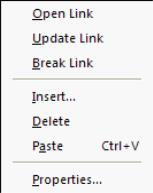Building a Model
Creating a Model
The first step in working with a model is to create the model object itself. There are several different ways of creating a model:
• You can create an empty model by using and then choosing , or by performing the same operation using the right mouse button menu from inside the workfile window.
• You can select a list of estimation objects in the workfile window (equations, VARs, systems), and then select from the right mouse button menu. This item will create a model which contains the equations from the selected objects as links.
• You can use the procedure from an estimation object to create a model containing the equation or equations in that object.
Adding Equations to the Model
The equations in a model can be classified into two types: linked equations and inline equations. Linked equations are equations that import their specification from other objects in the workfile. Inline equations are contained inside the model as text.
There are a number of ways to add equations to your model:
• To add a linked equation: from the workfile window, select the object which contains the equation, system, var, or equations you would like to add to the model, then copy-and-paste or drag-and-drop the object into the model equation view window.
• To add an equation using text: select from the right mouse button menu. In the text box titled: type in one or more equations in standard EViews format. You can also add linked equations from this dialog by typing a colon followed by the name of the object you would like to link to, for example “:EQ1”, because this is the text form of a linked object.
In an EViews model, the first variable that appears in an equation will be considered the endogenous variable for that equation. Since each endogenous variable can be associated with only one equation, you may need to rewrite your equations to ensure that each equation begins with a different variable. For example, say we have an equation in the model:
x / y = z
EViews will associate the equation with the variable X. If we would like the equation to be associated with the variable Y, we would have to rewrite the equation:
1 / y * x = z
Note that EViews has the ability to handle simple expressions involving the endogenous variable. You may use functions like LOG, D, and DLOG on the left-hand side of your equation. EViews will normalize the equation into explicit form if the Gauss-Seidel method is selected for solving the model.
Removing Equations from the Model
To remove equations from the model, simply select the equations using the mouse in Equation view, then use from the right mouse button menu to remove the equations.
Both adding and removing equations from the model will change which variables are considered endogenous to the model.
Updating Links in the Model
If a model contains linked equations, changes to the specification of the equations made outside the model can cause the equations contained in the model to become out of date. You can incorporate these changes in the model by using . Alternatively, you can update just a single equation using the item from the right mouse button menu. Links are also updated when a workfile is reloaded from disk.
Sometimes, you may want to sever equations in the model from their linked objects. For example, you may wish to see the entire model in text form, with all equations written in place. To do this, you can use the procedure to convert all linked equations in the model into inline text. You can convert just a single equation by selecting the equation, then using from the right mouse button menu.
When a link is broken, the equation is written in text form with the unknown coefficients replaced by their point estimates. Any information relating to uncertainty of the coefficients will be lost. This will have no effect on deterministic solutions to the model, but may alter the results of stochastic simulations if the option has been selected.

